Managing Across Cultures Report: INDU 1033, Module Report
VerifiedAdded on 2022/09/02
|18
|4004
|20
Report
AI Summary
This report, submitted by a student, delves into the multifaceted aspects of managing across cultures. It begins with a cultural interview and personal profile, contrasting cultural differences between an American interviewer and a Saudi Arabian interviewee, exploring theoretical models and societal norms. The report then reflects on cross-cultural competencies using the Gibbs Reflective Model, evaluating the benefits and challenges of multicultural work environments. Finally, it analyzes a case study on building cross-cultural sensitivity, examining challenges within multicultural teams and the importance of effective cross-cultural communication. The report highlights the significance of cultural awareness, sensitivity, and communication in fostering successful global management practices. It emphasizes the enriching nature of diverse work environments and the need for continuous learning and adaptation.
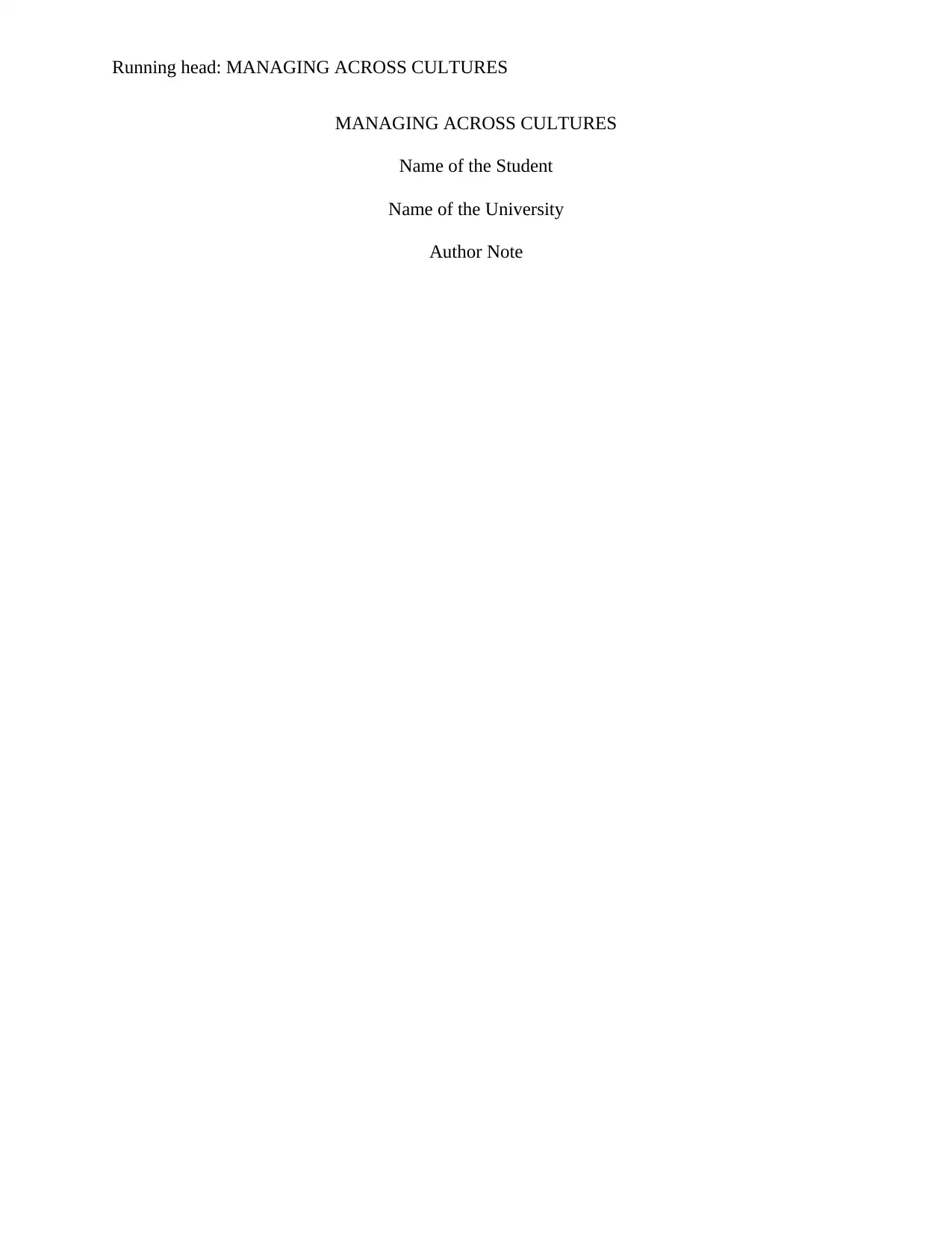
Running head: MANAGING ACROSS CULTURES
MANAGING ACROSS CULTURES
Name of the Student
Name of the University
Author Note
MANAGING ACROSS CULTURES
Name of the Student
Name of the University
Author Note
Paraphrase This Document
Need a fresh take? Get an instant paraphrase of this document with our AI Paraphraser
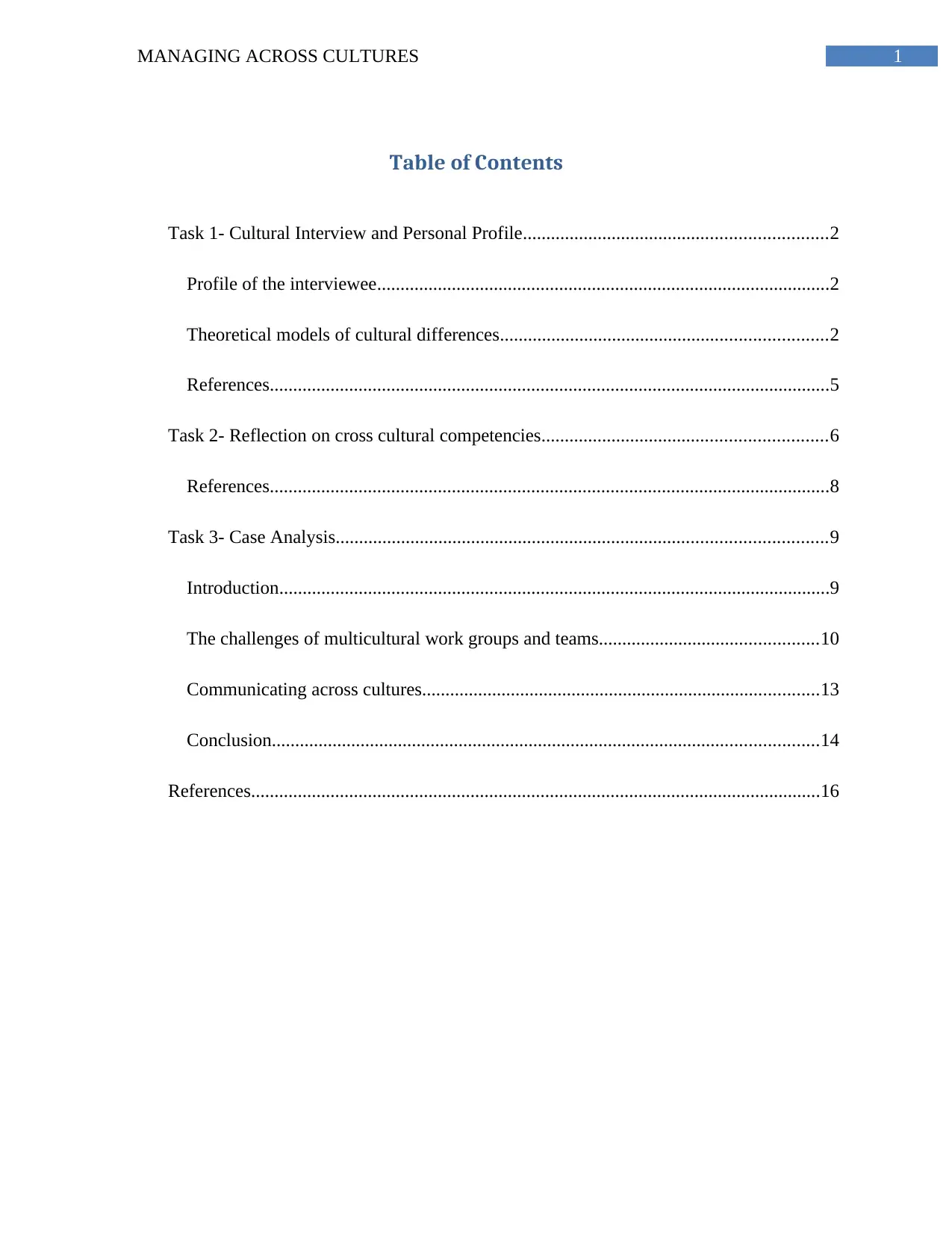
1MANAGING ACROSS CULTURES
Table of Contents
Task 1- Cultural Interview and Personal Profile.................................................................2
Profile of the interviewee.................................................................................................2
Theoretical models of cultural differences......................................................................2
References........................................................................................................................5
Task 2- Reflection on cross cultural competencies.............................................................6
References........................................................................................................................8
Task 3- Case Analysis.........................................................................................................9
Introduction......................................................................................................................9
The challenges of multicultural work groups and teams...............................................10
Communicating across cultures.....................................................................................13
Conclusion.....................................................................................................................14
References..........................................................................................................................16
Table of Contents
Task 1- Cultural Interview and Personal Profile.................................................................2
Profile of the interviewee.................................................................................................2
Theoretical models of cultural differences......................................................................2
References........................................................................................................................5
Task 2- Reflection on cross cultural competencies.............................................................6
References........................................................................................................................8
Task 3- Case Analysis.........................................................................................................9
Introduction......................................................................................................................9
The challenges of multicultural work groups and teams...............................................10
Communicating across cultures.....................................................................................13
Conclusion.....................................................................................................................14
References..........................................................................................................................16
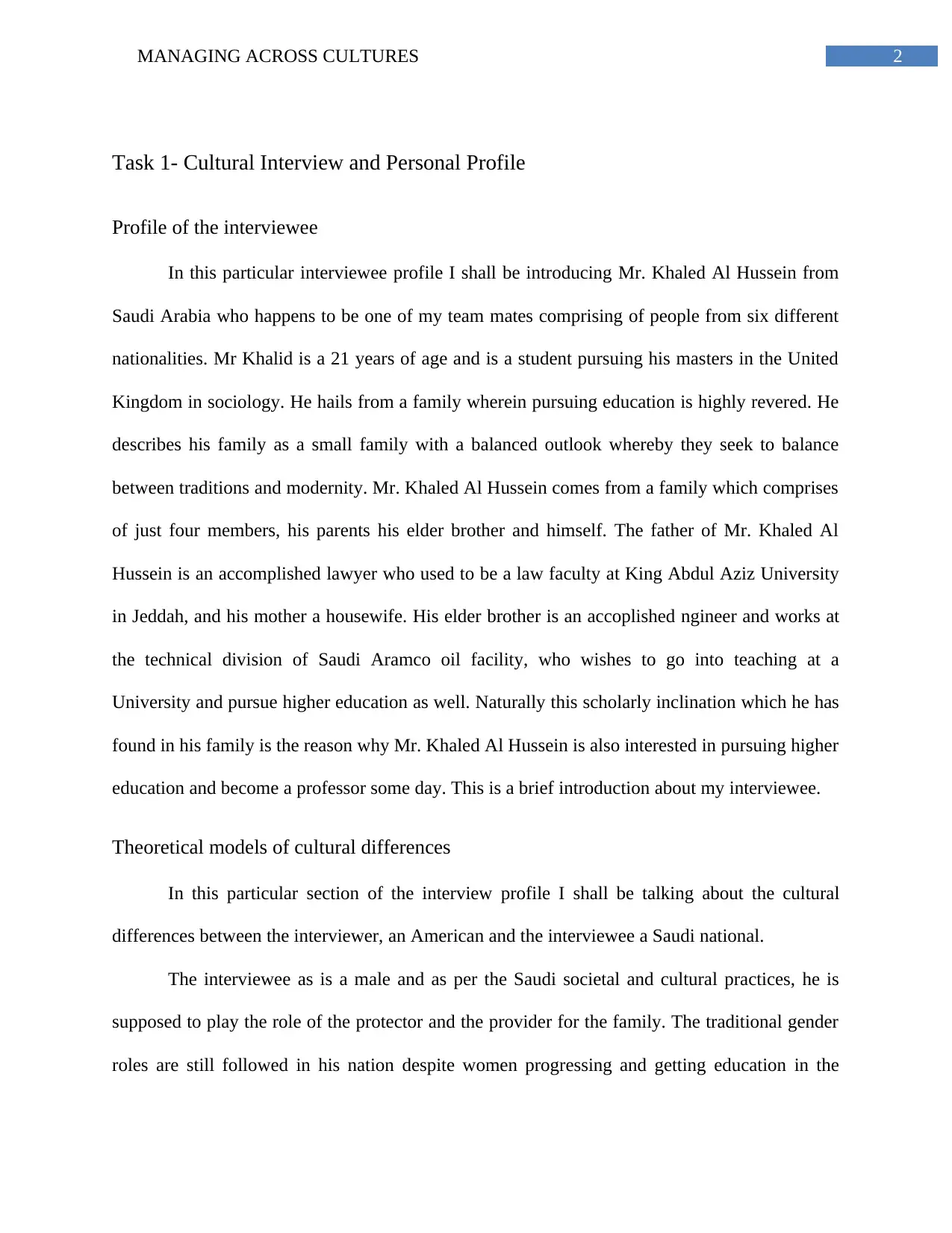
2MANAGING ACROSS CULTURES
Task 1- Cultural Interview and Personal Profile
Profile of the interviewee
In this particular interviewee profile I shall be introducing Mr. Khaled Al Hussein from
Saudi Arabia who happens to be one of my team mates comprising of people from six different
nationalities. Mr Khalid is a 21 years of age and is a student pursuing his masters in the United
Kingdom in sociology. He hails from a family wherein pursuing education is highly revered. He
describes his family as a small family with a balanced outlook whereby they seek to balance
between traditions and modernity. Mr. Khaled Al Hussein comes from a family which comprises
of just four members, his parents his elder brother and himself. The father of Mr. Khaled Al
Hussein is an accomplished lawyer who used to be a law faculty at King Abdul Aziz University
in Jeddah, and his mother a housewife. His elder brother is an accoplished ngineer and works at
the technical division of Saudi Aramco oil facility, who wishes to go into teaching at a
University and pursue higher education as well. Naturally this scholarly inclination which he has
found in his family is the reason why Mr. Khaled Al Hussein is also interested in pursuing higher
education and become a professor some day. This is a brief introduction about my interviewee.
Theoretical models of cultural differences
In this particular section of the interview profile I shall be talking about the cultural
differences between the interviewer, an American and the interviewee a Saudi national.
The interviewee as is a male and as per the Saudi societal and cultural practices, he is
supposed to play the role of the protector and the provider for the family. The traditional gender
roles are still followed in his nation despite women progressing and getting education in the
Task 1- Cultural Interview and Personal Profile
Profile of the interviewee
In this particular interviewee profile I shall be introducing Mr. Khaled Al Hussein from
Saudi Arabia who happens to be one of my team mates comprising of people from six different
nationalities. Mr Khalid is a 21 years of age and is a student pursuing his masters in the United
Kingdom in sociology. He hails from a family wherein pursuing education is highly revered. He
describes his family as a small family with a balanced outlook whereby they seek to balance
between traditions and modernity. Mr. Khaled Al Hussein comes from a family which comprises
of just four members, his parents his elder brother and himself. The father of Mr. Khaled Al
Hussein is an accomplished lawyer who used to be a law faculty at King Abdul Aziz University
in Jeddah, and his mother a housewife. His elder brother is an accoplished ngineer and works at
the technical division of Saudi Aramco oil facility, who wishes to go into teaching at a
University and pursue higher education as well. Naturally this scholarly inclination which he has
found in his family is the reason why Mr. Khaled Al Hussein is also interested in pursuing higher
education and become a professor some day. This is a brief introduction about my interviewee.
Theoretical models of cultural differences
In this particular section of the interview profile I shall be talking about the cultural
differences between the interviewer, an American and the interviewee a Saudi national.
The interviewee as is a male and as per the Saudi societal and cultural practices, he is
supposed to play the role of the protector and the provider for the family. The traditional gender
roles are still followed in his nation despite women progressing and getting education in the
⊘ This is a preview!⊘
Do you want full access?
Subscribe today to unlock all pages.

Trusted by 1+ million students worldwide

3MANAGING ACROSS CULTURES
contemporary times. This system is different from the norm of gender equality that is followed in
the USA (Steers, Nardon and Sanchez-Runde 2013).
Saudi family is hierarchical and patriarchal in nature and each member has to obey the
patriarch or the eldest male member of the family. Traditional gender roles also exist in the USA
but they are not as strict as it exists in Saudi owing to the fact that the American society is much
more open and women have more freedom and independence (Meyer 2016).
Saudis in general are not quite punctual and they take time for granted something which
is not appreciated in the USA. Mr. Khaled Al Hussein on the other hand is very punctual and that
shows that he is a balance between tradition and westernization (Steers, Nardon and Sanchez-
Runde 2013).
Saudis in general are not very favourably disposed to the idea of risk taking and that is
evident from their oil dependent economy, while in USA entrepreneurship in all scales are quite
popular. Mr. Khaled Al Hussein is also not favourably disposed to the idea of risk taking and is
quite conventional in his future career prospects (Meyer 2016).
Saudis are quite warm by nature and they usually greet members of the same sex with a
hug and that sort of gesture is only shared among close friends in the USA. Mr. Khaled Al
Hussein on the other hand prefers to be quite formal and usually shakes hand with non Arabs to
respect cultural differences and the perception of space (Molinsky 2013).
Like most Saudis, Mr. Khaled Al Hussein also prefers to gesticulate his hands a lot while
talking and that pattern of communication to be very expressive and passionate is something
which is reserved only for informal gatherings in the USA (Molinsky 2013).
contemporary times. This system is different from the norm of gender equality that is followed in
the USA (Steers, Nardon and Sanchez-Runde 2013).
Saudi family is hierarchical and patriarchal in nature and each member has to obey the
patriarch or the eldest male member of the family. Traditional gender roles also exist in the USA
but they are not as strict as it exists in Saudi owing to the fact that the American society is much
more open and women have more freedom and independence (Meyer 2016).
Saudis in general are not quite punctual and they take time for granted something which
is not appreciated in the USA. Mr. Khaled Al Hussein on the other hand is very punctual and that
shows that he is a balance between tradition and westernization (Steers, Nardon and Sanchez-
Runde 2013).
Saudis in general are not very favourably disposed to the idea of risk taking and that is
evident from their oil dependent economy, while in USA entrepreneurship in all scales are quite
popular. Mr. Khaled Al Hussein is also not favourably disposed to the idea of risk taking and is
quite conventional in his future career prospects (Meyer 2016).
Saudis are quite warm by nature and they usually greet members of the same sex with a
hug and that sort of gesture is only shared among close friends in the USA. Mr. Khaled Al
Hussein on the other hand prefers to be quite formal and usually shakes hand with non Arabs to
respect cultural differences and the perception of space (Molinsky 2013).
Like most Saudis, Mr. Khaled Al Hussein also prefers to gesticulate his hands a lot while
talking and that pattern of communication to be very expressive and passionate is something
which is reserved only for informal gatherings in the USA (Molinsky 2013).
Paraphrase This Document
Need a fresh take? Get an instant paraphrase of this document with our AI Paraphraser
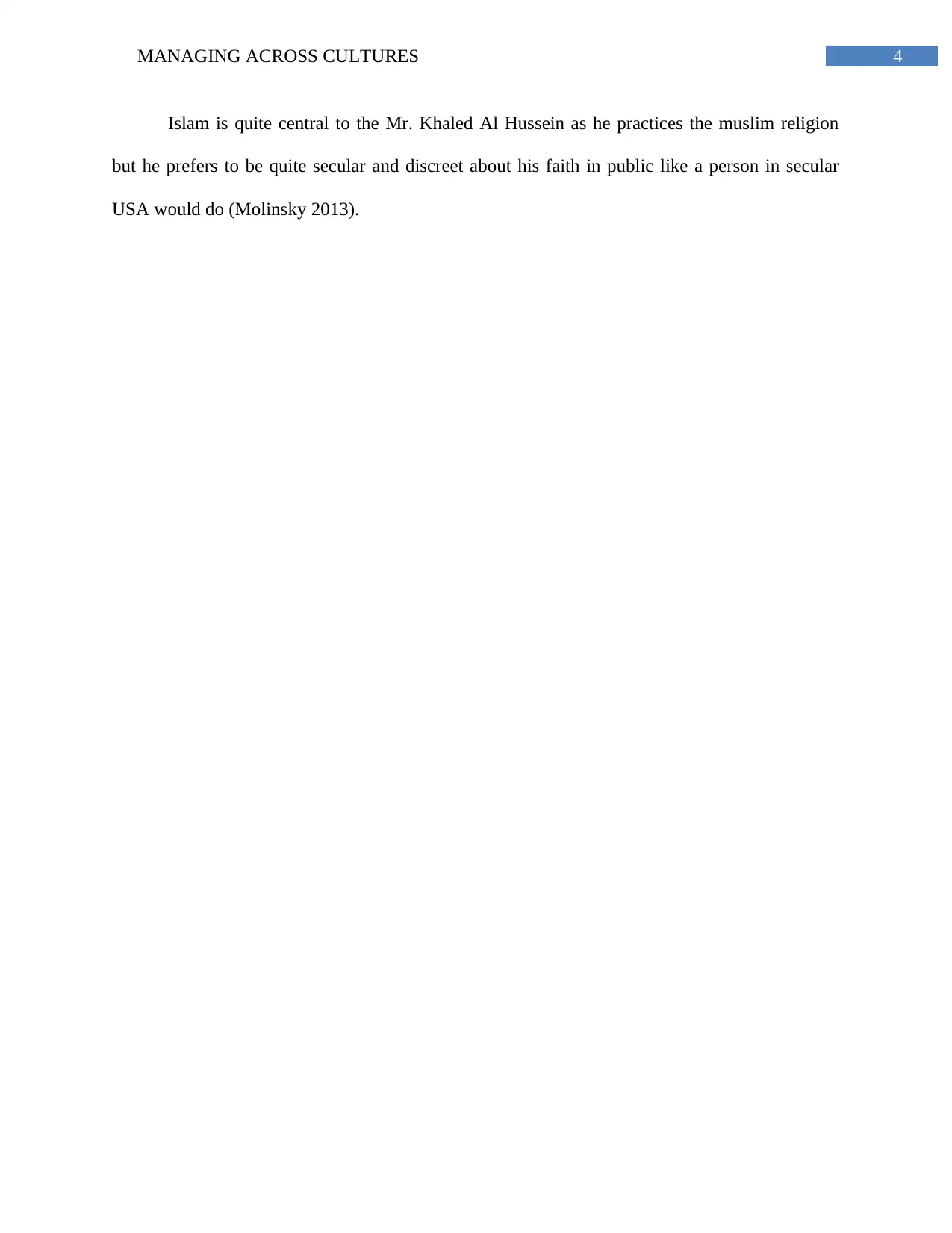
4MANAGING ACROSS CULTURES
Islam is quite central to the Mr. Khaled Al Hussein as he practices the muslim religion
but he prefers to be quite secular and discreet about his faith in public like a person in secular
USA would do (Molinsky 2013).
Islam is quite central to the Mr. Khaled Al Hussein as he practices the muslim religion
but he prefers to be quite secular and discreet about his faith in public like a person in secular
USA would do (Molinsky 2013).
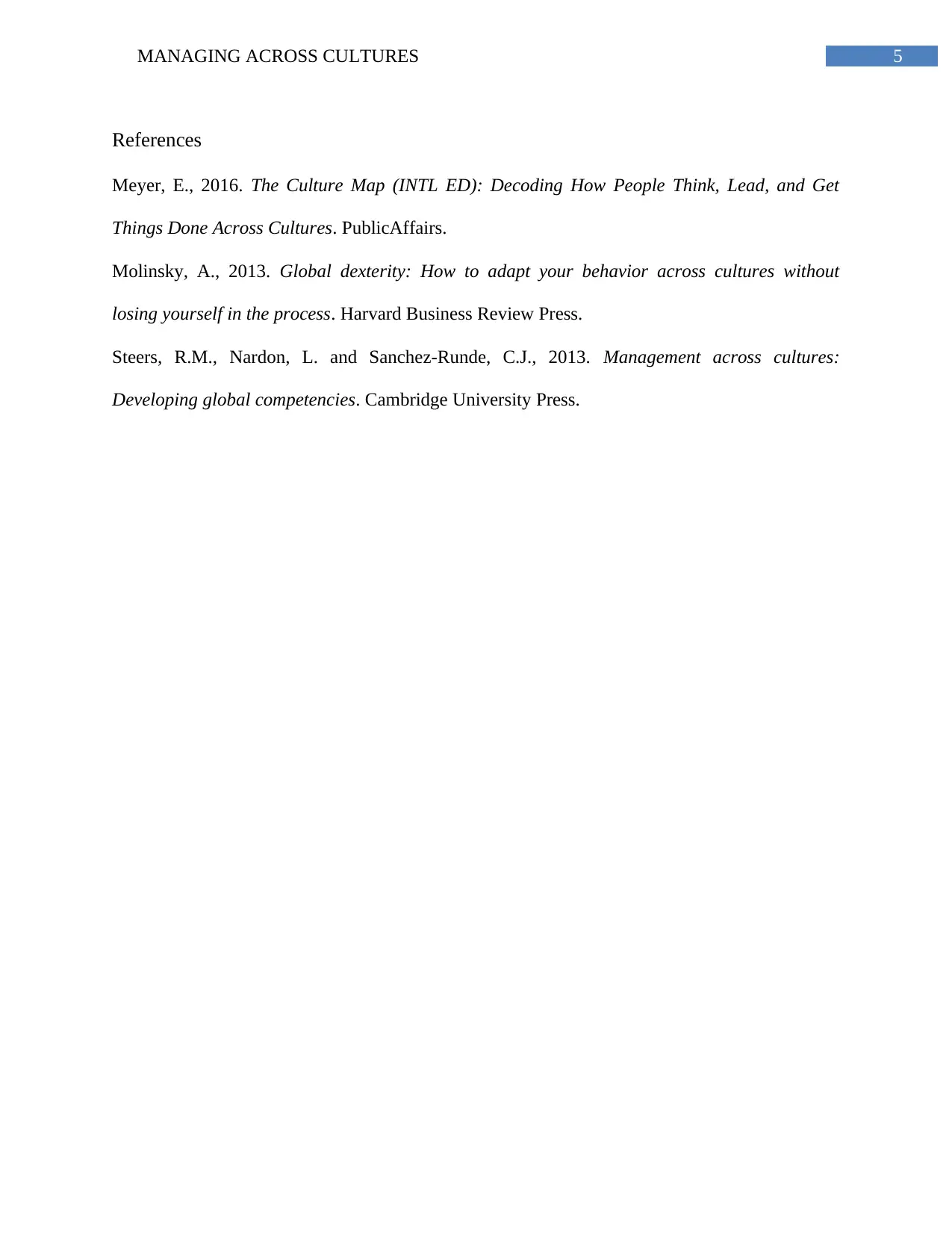
5MANAGING ACROSS CULTURES
References
Meyer, E., 2016. The Culture Map (INTL ED): Decoding How People Think, Lead, and Get
Things Done Across Cultures. PublicAffairs.
Molinsky, A., 2013. Global dexterity: How to adapt your behavior across cultures without
losing yourself in the process. Harvard Business Review Press.
Steers, R.M., Nardon, L. and Sanchez-Runde, C.J., 2013. Management across cultures:
Developing global competencies. Cambridge University Press.
References
Meyer, E., 2016. The Culture Map (INTL ED): Decoding How People Think, Lead, and Get
Things Done Across Cultures. PublicAffairs.
Molinsky, A., 2013. Global dexterity: How to adapt your behavior across cultures without
losing yourself in the process. Harvard Business Review Press.
Steers, R.M., Nardon, L. and Sanchez-Runde, C.J., 2013. Management across cultures:
Developing global competencies. Cambridge University Press.
⊘ This is a preview!⊘
Do you want full access?
Subscribe today to unlock all pages.

Trusted by 1+ million students worldwide
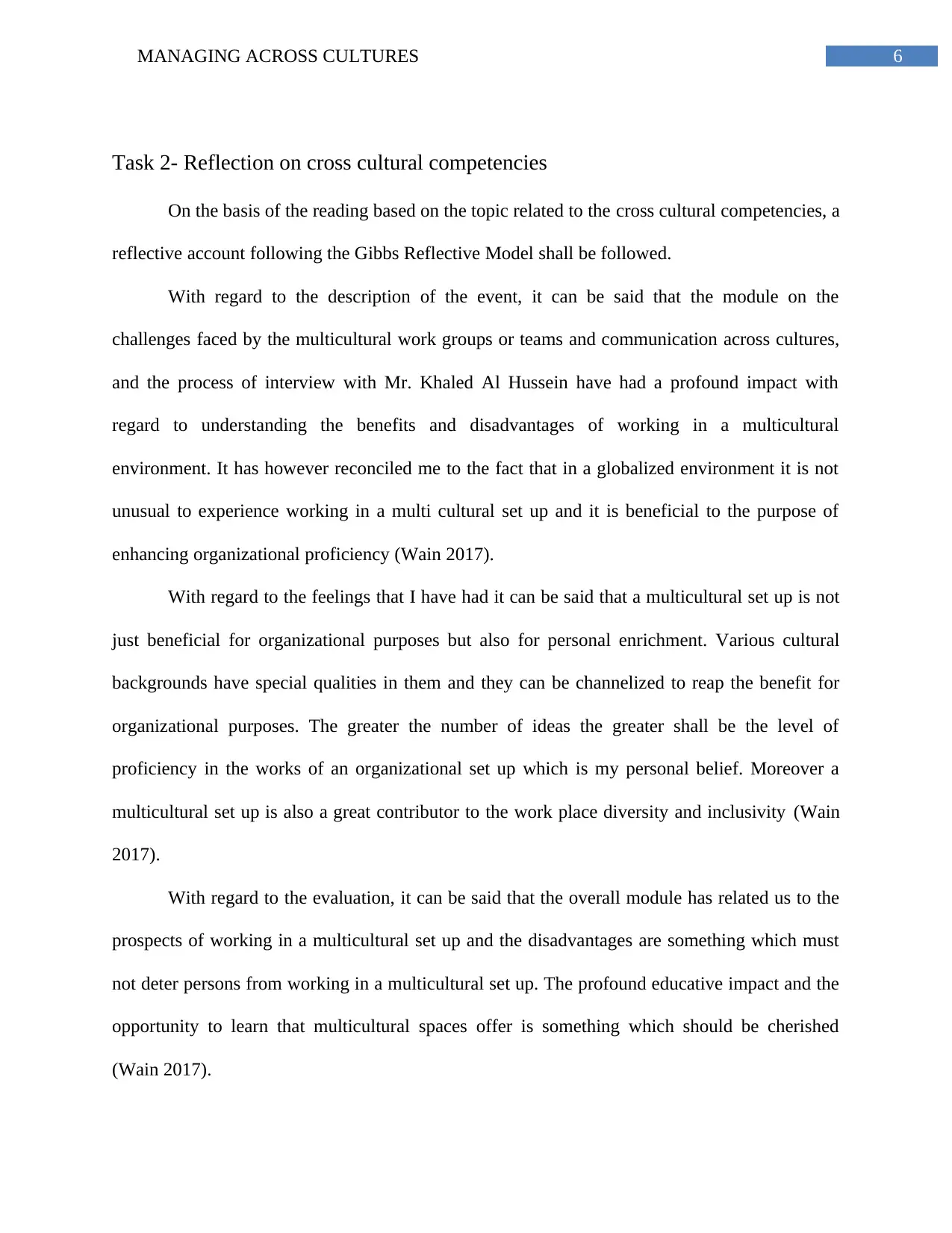
6MANAGING ACROSS CULTURES
Task 2- Reflection on cross cultural competencies
On the basis of the reading based on the topic related to the cross cultural competencies, a
reflective account following the Gibbs Reflective Model shall be followed.
With regard to the description of the event, it can be said that the module on the
challenges faced by the multicultural work groups or teams and communication across cultures,
and the process of interview with Mr. Khaled Al Hussein have had a profound impact with
regard to understanding the benefits and disadvantages of working in a multicultural
environment. It has however reconciled me to the fact that in a globalized environment it is not
unusual to experience working in a multi cultural set up and it is beneficial to the purpose of
enhancing organizational proficiency (Wain 2017).
With regard to the feelings that I have had it can be said that a multicultural set up is not
just beneficial for organizational purposes but also for personal enrichment. Various cultural
backgrounds have special qualities in them and they can be channelized to reap the benefit for
organizational purposes. The greater the number of ideas the greater shall be the level of
proficiency in the works of an organizational set up which is my personal belief. Moreover a
multicultural set up is also a great contributor to the work place diversity and inclusivity (Wain
2017).
With regard to the evaluation, it can be said that the overall module has related us to the
prospects of working in a multicultural set up and the disadvantages are something which must
not deter persons from working in a multicultural set up. The profound educative impact and the
opportunity to learn that multicultural spaces offer is something which should be cherished
(Wain 2017).
Task 2- Reflection on cross cultural competencies
On the basis of the reading based on the topic related to the cross cultural competencies, a
reflective account following the Gibbs Reflective Model shall be followed.
With regard to the description of the event, it can be said that the module on the
challenges faced by the multicultural work groups or teams and communication across cultures,
and the process of interview with Mr. Khaled Al Hussein have had a profound impact with
regard to understanding the benefits and disadvantages of working in a multicultural
environment. It has however reconciled me to the fact that in a globalized environment it is not
unusual to experience working in a multi cultural set up and it is beneficial to the purpose of
enhancing organizational proficiency (Wain 2017).
With regard to the feelings that I have had it can be said that a multicultural set up is not
just beneficial for organizational purposes but also for personal enrichment. Various cultural
backgrounds have special qualities in them and they can be channelized to reap the benefit for
organizational purposes. The greater the number of ideas the greater shall be the level of
proficiency in the works of an organizational set up which is my personal belief. Moreover a
multicultural set up is also a great contributor to the work place diversity and inclusivity (Wain
2017).
With regard to the evaluation, it can be said that the overall module has related us to the
prospects of working in a multicultural set up and the disadvantages are something which must
not deter persons from working in a multicultural set up. The profound educative impact and the
opportunity to learn that multicultural spaces offer is something which should be cherished
(Wain 2017).
Paraphrase This Document
Need a fresh take? Get an instant paraphrase of this document with our AI Paraphraser
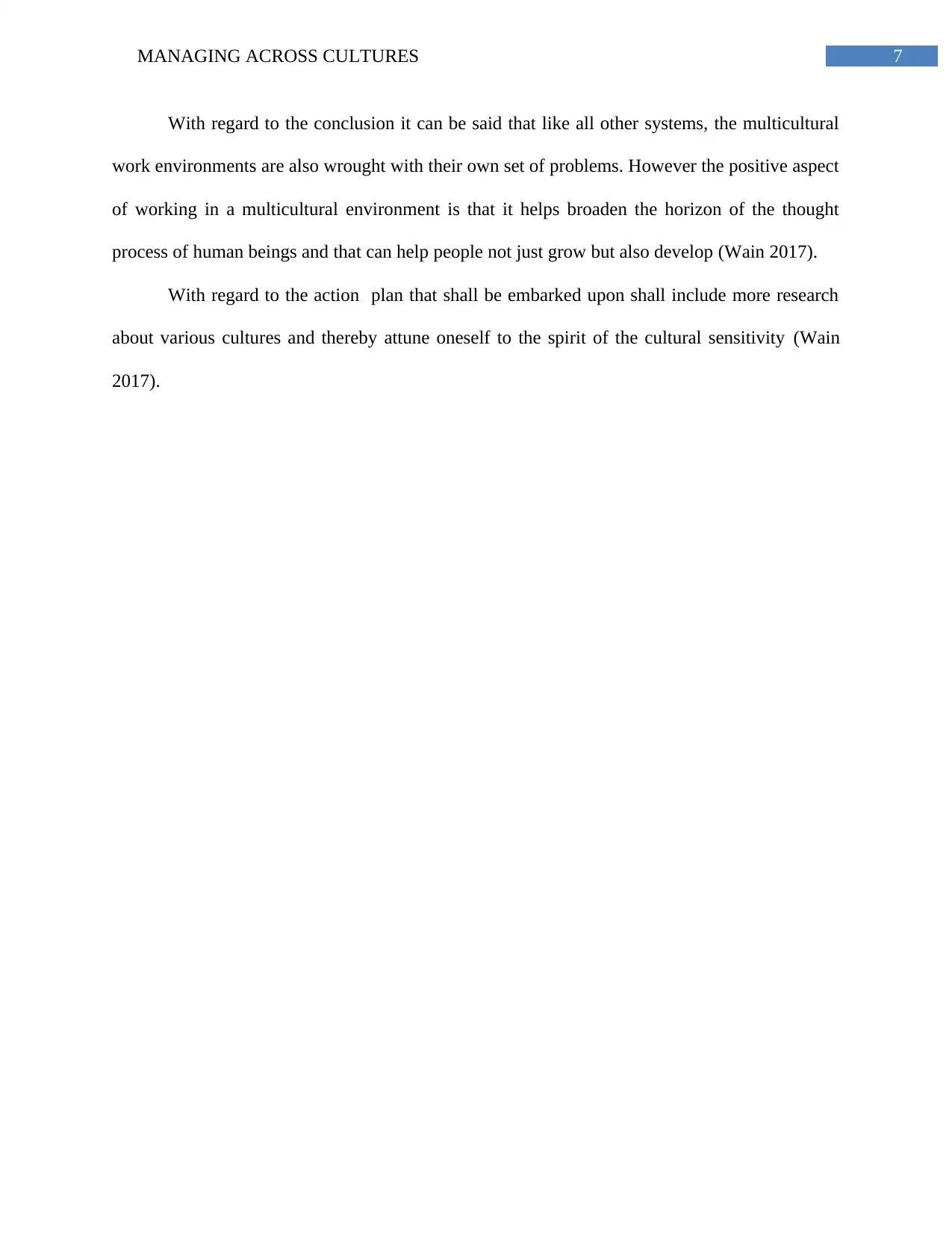
7MANAGING ACROSS CULTURES
With regard to the conclusion it can be said that like all other systems, the multicultural
work environments are also wrought with their own set of problems. However the positive aspect
of working in a multicultural environment is that it helps broaden the horizon of the thought
process of human beings and that can help people not just grow but also develop (Wain 2017).
With regard to the action plan that shall be embarked upon shall include more research
about various cultures and thereby attune oneself to the spirit of the cultural sensitivity (Wain
2017).
With regard to the conclusion it can be said that like all other systems, the multicultural
work environments are also wrought with their own set of problems. However the positive aspect
of working in a multicultural environment is that it helps broaden the horizon of the thought
process of human beings and that can help people not just grow but also develop (Wain 2017).
With regard to the action plan that shall be embarked upon shall include more research
about various cultures and thereby attune oneself to the spirit of the cultural sensitivity (Wain
2017).

8MANAGING ACROSS CULTURES
References
Wain, A., 2017. Learning through reflection. British Journal of Midwifery, 25(10), pp.662-666.
References
Wain, A., 2017. Learning through reflection. British Journal of Midwifery, 25(10), pp.662-666.
⊘ This is a preview!⊘
Do you want full access?
Subscribe today to unlock all pages.

Trusted by 1+ million students worldwide
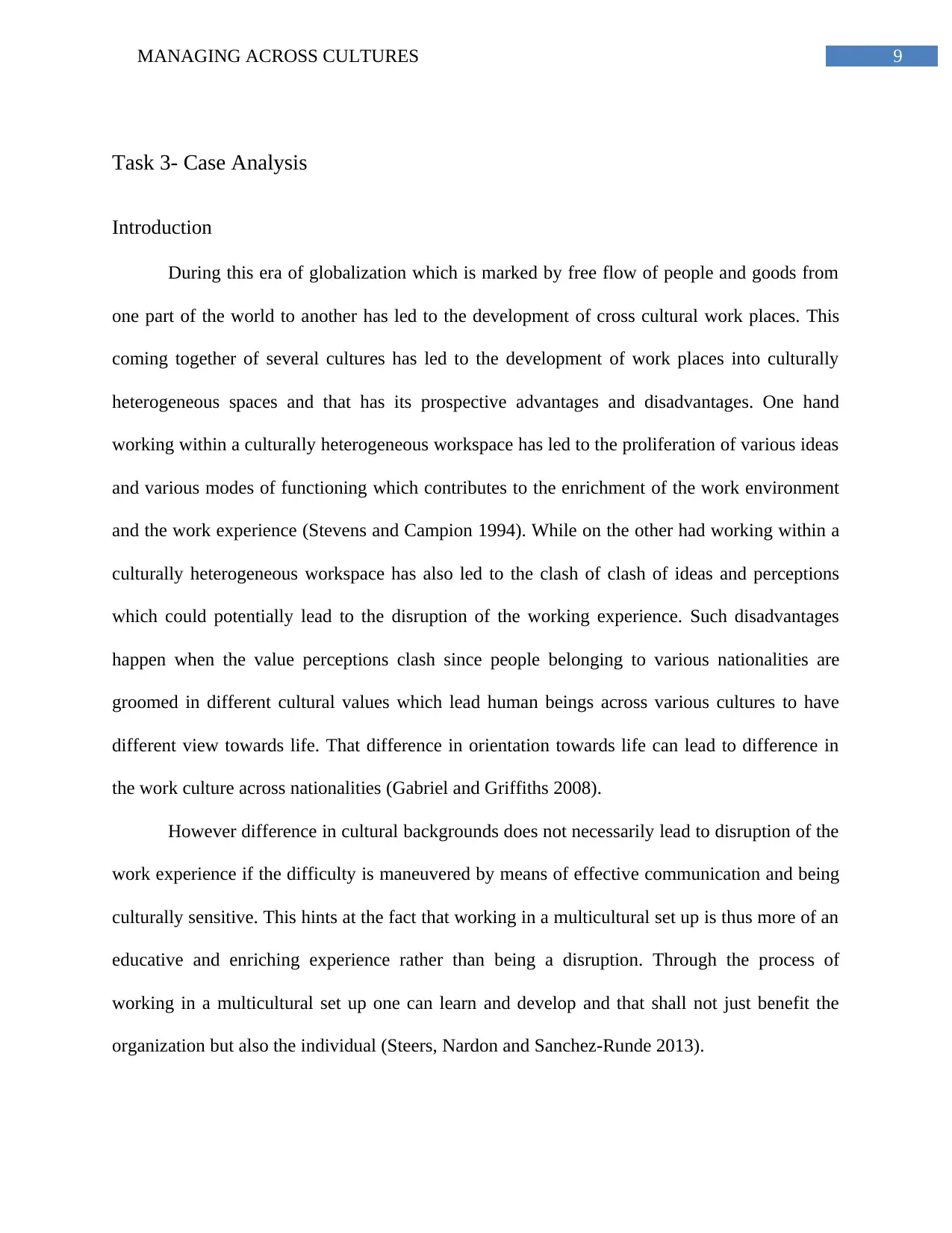
9MANAGING ACROSS CULTURES
Task 3- Case Analysis
Introduction
During this era of globalization which is marked by free flow of people and goods from
one part of the world to another has led to the development of cross cultural work places. This
coming together of several cultures has led to the development of work places into culturally
heterogeneous spaces and that has its prospective advantages and disadvantages. One hand
working within a culturally heterogeneous workspace has led to the proliferation of various ideas
and various modes of functioning which contributes to the enrichment of the work environment
and the work experience (Stevens and Campion 1994). While on the other had working within a
culturally heterogeneous workspace has also led to the clash of clash of ideas and perceptions
which could potentially lead to the disruption of the working experience. Such disadvantages
happen when the value perceptions clash since people belonging to various nationalities are
groomed in different cultural values which lead human beings across various cultures to have
different view towards life. That difference in orientation towards life can lead to difference in
the work culture across nationalities (Gabriel and Griffiths 2008).
However difference in cultural backgrounds does not necessarily lead to disruption of the
work experience if the difficulty is maneuvered by means of effective communication and being
culturally sensitive. This hints at the fact that working in a multicultural set up is thus more of an
educative and enriching experience rather than being a disruption. Through the process of
working in a multicultural set up one can learn and develop and that shall not just benefit the
organization but also the individual (Steers, Nardon and Sanchez-Runde 2013).
Task 3- Case Analysis
Introduction
During this era of globalization which is marked by free flow of people and goods from
one part of the world to another has led to the development of cross cultural work places. This
coming together of several cultures has led to the development of work places into culturally
heterogeneous spaces and that has its prospective advantages and disadvantages. One hand
working within a culturally heterogeneous workspace has led to the proliferation of various ideas
and various modes of functioning which contributes to the enrichment of the work environment
and the work experience (Stevens and Campion 1994). While on the other had working within a
culturally heterogeneous workspace has also led to the clash of clash of ideas and perceptions
which could potentially lead to the disruption of the working experience. Such disadvantages
happen when the value perceptions clash since people belonging to various nationalities are
groomed in different cultural values which lead human beings across various cultures to have
different view towards life. That difference in orientation towards life can lead to difference in
the work culture across nationalities (Gabriel and Griffiths 2008).
However difference in cultural backgrounds does not necessarily lead to disruption of the
work experience if the difficulty is maneuvered by means of effective communication and being
culturally sensitive. This hints at the fact that working in a multicultural set up is thus more of an
educative and enriching experience rather than being a disruption. Through the process of
working in a multicultural set up one can learn and develop and that shall not just benefit the
organization but also the individual (Steers, Nardon and Sanchez-Runde 2013).
Paraphrase This Document
Need a fresh take? Get an instant paraphrase of this document with our AI Paraphraser
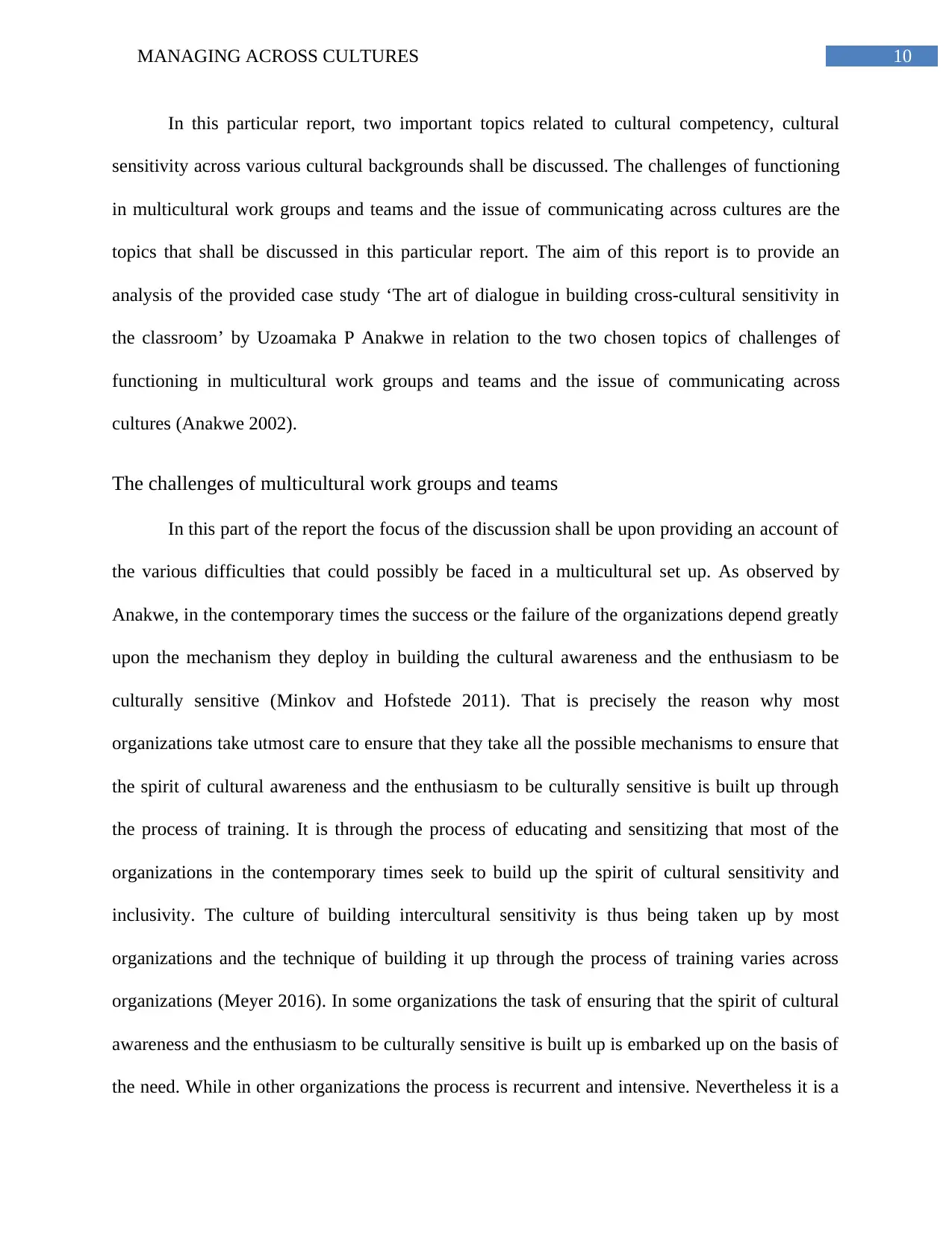
10MANAGING ACROSS CULTURES
In this particular report, two important topics related to cultural competency, cultural
sensitivity across various cultural backgrounds shall be discussed. The challenges of functioning
in multicultural work groups and teams and the issue of communicating across cultures are the
topics that shall be discussed in this particular report. The aim of this report is to provide an
analysis of the provided case study ‘The art of dialogue in building cross-cultural sensitivity in
the classroom’ by Uzoamaka P Anakwe in relation to the two chosen topics of challenges of
functioning in multicultural work groups and teams and the issue of communicating across
cultures (Anakwe 2002).
The challenges of multicultural work groups and teams
In this part of the report the focus of the discussion shall be upon providing an account of
the various difficulties that could possibly be faced in a multicultural set up. As observed by
Anakwe, in the contemporary times the success or the failure of the organizations depend greatly
upon the mechanism they deploy in building the cultural awareness and the enthusiasm to be
culturally sensitive (Minkov and Hofstede 2011). That is precisely the reason why most
organizations take utmost care to ensure that they take all the possible mechanisms to ensure that
the spirit of cultural awareness and the enthusiasm to be culturally sensitive is built up through
the process of training. It is through the process of educating and sensitizing that most of the
organizations in the contemporary times seek to build up the spirit of cultural sensitivity and
inclusivity. The culture of building intercultural sensitivity is thus being taken up by most
organizations and the technique of building it up through the process of training varies across
organizations (Meyer 2016). In some organizations the task of ensuring that the spirit of cultural
awareness and the enthusiasm to be culturally sensitive is built up is embarked up on the basis of
the need. While in other organizations the process is recurrent and intensive. Nevertheless it is a
In this particular report, two important topics related to cultural competency, cultural
sensitivity across various cultural backgrounds shall be discussed. The challenges of functioning
in multicultural work groups and teams and the issue of communicating across cultures are the
topics that shall be discussed in this particular report. The aim of this report is to provide an
analysis of the provided case study ‘The art of dialogue in building cross-cultural sensitivity in
the classroom’ by Uzoamaka P Anakwe in relation to the two chosen topics of challenges of
functioning in multicultural work groups and teams and the issue of communicating across
cultures (Anakwe 2002).
The challenges of multicultural work groups and teams
In this part of the report the focus of the discussion shall be upon providing an account of
the various difficulties that could possibly be faced in a multicultural set up. As observed by
Anakwe, in the contemporary times the success or the failure of the organizations depend greatly
upon the mechanism they deploy in building the cultural awareness and the enthusiasm to be
culturally sensitive (Minkov and Hofstede 2011). That is precisely the reason why most
organizations take utmost care to ensure that they take all the possible mechanisms to ensure that
the spirit of cultural awareness and the enthusiasm to be culturally sensitive is built up through
the process of training. It is through the process of educating and sensitizing that most of the
organizations in the contemporary times seek to build up the spirit of cultural sensitivity and
inclusivity. The culture of building intercultural sensitivity is thus being taken up by most
organizations and the technique of building it up through the process of training varies across
organizations (Meyer 2016). In some organizations the task of ensuring that the spirit of cultural
awareness and the enthusiasm to be culturally sensitive is built up is embarked up on the basis of
the need. While in other organizations the process is recurrent and intensive. Nevertheless it is a
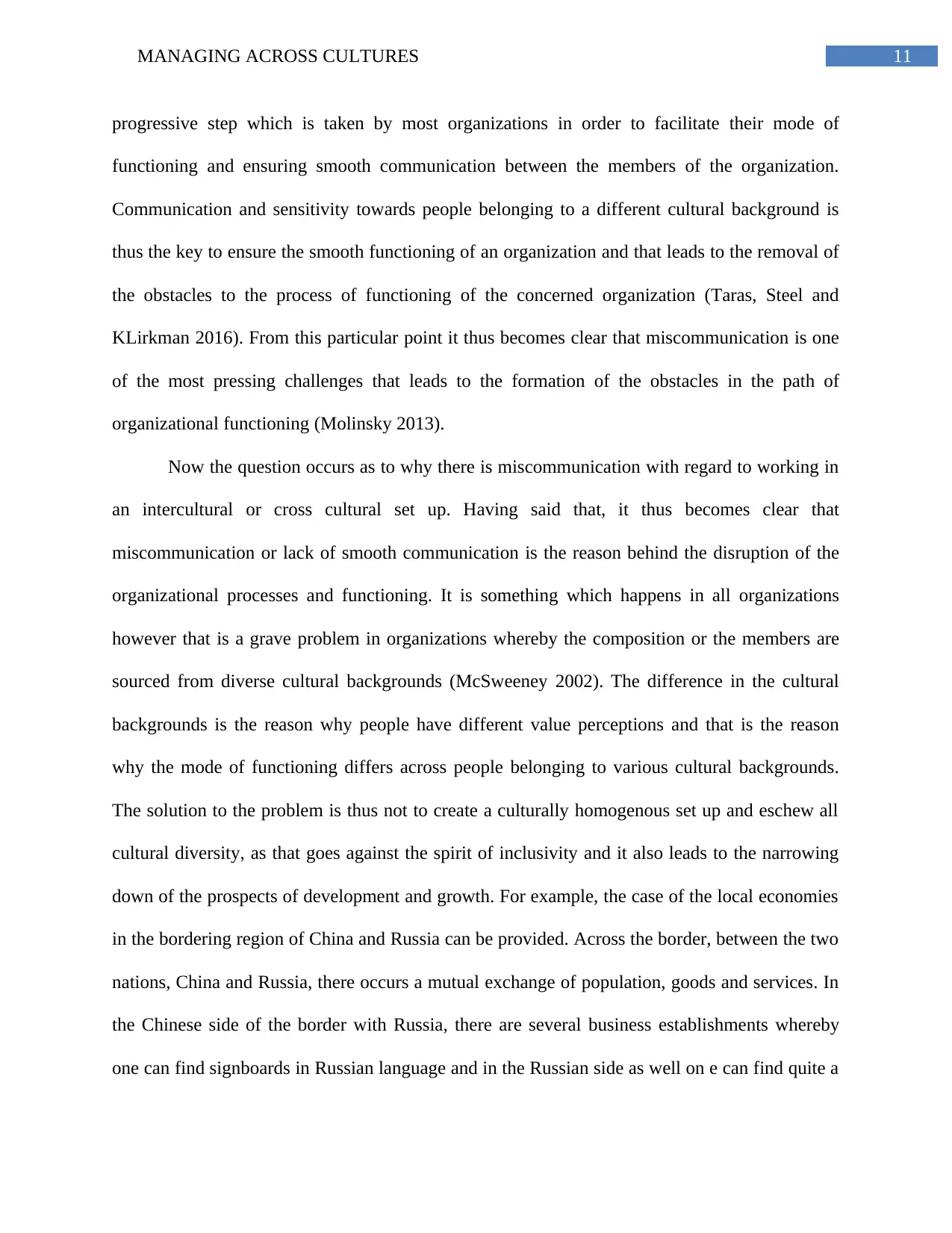
11MANAGING ACROSS CULTURES
progressive step which is taken by most organizations in order to facilitate their mode of
functioning and ensuring smooth communication between the members of the organization.
Communication and sensitivity towards people belonging to a different cultural background is
thus the key to ensure the smooth functioning of an organization and that leads to the removal of
the obstacles to the process of functioning of the concerned organization (Taras, Steel and
KLirkman 2016). From this particular point it thus becomes clear that miscommunication is one
of the most pressing challenges that leads to the formation of the obstacles in the path of
organizational functioning (Molinsky 2013).
Now the question occurs as to why there is miscommunication with regard to working in
an intercultural or cross cultural set up. Having said that, it thus becomes clear that
miscommunication or lack of smooth communication is the reason behind the disruption of the
organizational processes and functioning. It is something which happens in all organizations
however that is a grave problem in organizations whereby the composition or the members are
sourced from diverse cultural backgrounds (McSweeney 2002). The difference in the cultural
backgrounds is the reason why people have different value perceptions and that is the reason
why the mode of functioning differs across people belonging to various cultural backgrounds.
The solution to the problem is thus not to create a culturally homogenous set up and eschew all
cultural diversity, as that goes against the spirit of inclusivity and it also leads to the narrowing
down of the prospects of development and growth. For example, the case of the local economies
in the bordering region of China and Russia can be provided. Across the border, between the two
nations, China and Russia, there occurs a mutual exchange of population, goods and services. In
the Chinese side of the border with Russia, there are several business establishments whereby
one can find signboards in Russian language and in the Russian side as well on e can find quite a
progressive step which is taken by most organizations in order to facilitate their mode of
functioning and ensuring smooth communication between the members of the organization.
Communication and sensitivity towards people belonging to a different cultural background is
thus the key to ensure the smooth functioning of an organization and that leads to the removal of
the obstacles to the process of functioning of the concerned organization (Taras, Steel and
KLirkman 2016). From this particular point it thus becomes clear that miscommunication is one
of the most pressing challenges that leads to the formation of the obstacles in the path of
organizational functioning (Molinsky 2013).
Now the question occurs as to why there is miscommunication with regard to working in
an intercultural or cross cultural set up. Having said that, it thus becomes clear that
miscommunication or lack of smooth communication is the reason behind the disruption of the
organizational processes and functioning. It is something which happens in all organizations
however that is a grave problem in organizations whereby the composition or the members are
sourced from diverse cultural backgrounds (McSweeney 2002). The difference in the cultural
backgrounds is the reason why people have different value perceptions and that is the reason
why the mode of functioning differs across people belonging to various cultural backgrounds.
The solution to the problem is thus not to create a culturally homogenous set up and eschew all
cultural diversity, as that goes against the spirit of inclusivity and it also leads to the narrowing
down of the prospects of development and growth. For example, the case of the local economies
in the bordering region of China and Russia can be provided. Across the border, between the two
nations, China and Russia, there occurs a mutual exchange of population, goods and services. In
the Chinese side of the border with Russia, there are several business establishments whereby
one can find signboards in Russian language and in the Russian side as well on e can find quite a
⊘ This is a preview!⊘
Do you want full access?
Subscribe today to unlock all pages.

Trusted by 1+ million students worldwide
1 out of 18
Your All-in-One AI-Powered Toolkit for Academic Success.
+13062052269
info@desklib.com
Available 24*7 on WhatsApp / Email
![[object Object]](/_next/static/media/star-bottom.7253800d.svg)
Unlock your academic potential
Copyright © 2020–2025 A2Z Services. All Rights Reserved. Developed and managed by ZUCOL.
